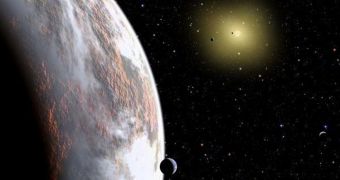When the first super-Earth-class extrasolar planets were discovered, astronomers proposed that some of them may be friendly to life, regardless of their size. In a new study, that enthusiasm is somewhat dampened, as experts learn that these worlds may lack a protective magnetic field.
The absence of such planetary defenses would make it nearly impossible for life to develop there, for multiple reasons. One of them is that the amount of radiation produced by that exoplanet's parent star would bathe the surface of the world, triggering extremely harsh conditions.
On Earth, the magnetosphere protects us from both solar winds and cosmic rays, deflecting most of them back into space, and preventing them from hitting the surface. But super-Earths – worlds a few times larger than our own – may not benefit from such protection.
The team behind the new study likened these prospective super-Earths to Mars, since our neighboring planet also features no protective magnetic fields. Planetary magnetism is triggered by the motions of a core inside a liquid mantle.
According to Earth scientists, the iron core needs to be at least partly molten in order for the effect to appear. But a computer model has just revealed that the cores of worlds between 1 and 10 times heavier than Earth will most likely be kept solid by high pressures.
The investigation was carried out by researcher Guillaume Morard. He and his team are based at the Institute of Mineralogy and Physics of Condensed Matter, in Paris, France. They say that another negative aspect of not having a magnetic field is that planets' atmospheres tend to get stripped off.
This is precisely what astronomers believe happened on Mars, a world that may have once been habitable, and even featured liquid water on its surface. However, climate change and a shift in its axis caused the world to be become frigid and barren.
When its core stopped spinning, the magnetosphere disappeared, and nearly the entire Martian atmosphere was eroded away, particle by particle, Daily Galaxy reports. Studies have revealed that the planet's core stopped spinning around 500 million years ago.
German Aerospace Center (DLR) investigator Vlada Stamankovic says that the findings make sense, but adds that more work is needed before a clear conclusion can be drawn. The scientist says that temperatures inside super-Earths may be larger than expected, a scenario that would allow for the existence of a molten iron core.

 14 DAY TRIAL //
14 DAY TRIAL //